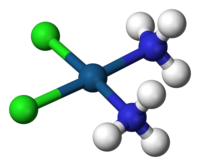
Photo from wikipedia
ABSTRACT. Magnesium, calcium, strontium, and barium complexes of uracil were prepared in a 2:1 ligand to metal ratio to investigate the ligational character of the uracil (Ura). The modes of… Click to show full abstract
ABSTRACT. Magnesium, calcium, strontium, and barium complexes of uracil were prepared in a 2:1 ligand to metal ratio to investigate the ligational character of the uracil (Ura). The modes of chelation were explained depending on elemental analyses, FT. IR, 1H–NMR spectra as well as scanning electron microscopy. Uracil has two donation sites either through N(3) and C(2)=O, or through N(3) and C(4)=O with the molecular formulas [M(Ura)2(H2O)2]Cl2 where M = Mg(II), Ca(II), Sr(II) and Ba(II) . The morphological surface and particle size of uracil metal complexes were determined using SEM and TEM. The thermal behaviors of the complexes were studied by the TGA (DTG) technique. The data obtained agreed well the proposed structures and showed that the complexes were finally decomposed to the corresponding metal oxide. The thermodynamic parameters are calculated from the thermal analysis curves using the Coats–Redfern and Horowitz–Metzger methods. The negative values of deduced the ordered structures of the prepared complexes compared to their starting reactants. Antibacterial activity of ligands and complexes is evaluated with two types of bacteria Staphylococcus aureus (gram‐positive) and Escherichia coli (gram‐negative) by the agar-well diffusion technique using DMSO as a solvent. KEY WORDS: Uracil, Coordination compounds, Non-isothermal kinetic parameters, Elemental analysis, Spectral studies, Biological efficiency Bull. Chem. Soc. Ethiop. 2023, 37(4), 945-957. DOI: https://dx.doi.org/10.4314/bcse.v37i4.11
Journal Title: Bulletin of the Chemical Society of Ethiopia
Year Published: 2023
Link to full text (if available)
Share on Social Media: Sign Up to like & get
recommendations!